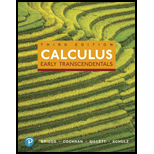
Concept explainers
a.
Whether the statement “If
a.
Answer to Problem 1RE
The statement is false.
Explanation of Solution
The given
Substitute
Thus, the constant vector is
Hence the statement if
b.
Whether the statement “The curvature of a circle of radius 5 is
b.
Answer to Problem 1RE
The given statement is true.
Explanation of Solution
Definition used:
“The curvature of a curve at a point can be visualized in terms of a circle of curvature, which is a circle of radius R that is tangent to the curve at that point.
The curvature at the point is
Description:
The given circle has the radius of 5.
By the above definition used, the curvature of a circle is reciprocal of the radius of the circle.
Thus, the curvature of the circle is
Hence, the statement “the curvature of a circle of radius 5 is
c.
Whether the statement “The graph of the curve
c.
Answer to Problem 1RE
The given statement is true.
Explanation of Solution
Definition used:
One point to a curve corresponds to a single vector
The entire curve can be represented by a vector-valued function
Calculation:
The given graph is
The values are
Here,
That is
Therefore, the statement “the graph of the curve
d.
Whether the given statement “If
d.
Answer to Problem 1RE
The given statement is true.
Explanation of Solution
Consider
Thus, the vector
Therefore, the given statement is true.
e.
Whether the statement “The parameterized curve
e.
Answer to Problem 1RE
The given statement is false.
Explanation of Solution
Suppose
Differentiate
Compute
Since
Therefore, the given statement is false.
f.
Whether the statement “The position vector and the principal unit normal are always parallel on a smooth curve.” is true or not.
f.
Answer to Problem 1RE
The given statement is false.
Explanation of Solution
Formula used:
Suppose r is a smooth parameterized curve and s is the arc length.
The unit tangent vector T is
The principal unit normal vector is
Counter example:
Consider
Differentiate
Use magnitude formula to obtain the value of
On further simplification,
Use unit tangent formula to compute
Thus, the unit tangent vector
Differentiate
Use magnitude formula to obtain the value of
On further simplification,
Use principal unit normal formula to compute the value of
Thus, the principal unit normal vector
It is observed that the position vector and the principal unit normal vector are not equal.
Therefore, the given statement is false.
Want to see more full solutions like this?
Chapter 14 Solutions
MyLab Math with Pearson eText -- Standalone Access Card -- for Calculus: Early Transcendentals (3rd Edition)
Additional Math Textbook Solutions
Thinking Mathematically (6th Edition)
Elementary Statistics (13th Edition)
University Calculus: Early Transcendentals (4th Edition)
Pre-Algebra Student Edition
A First Course in Probability (10th Edition)
- Suppose that a particle moves along a straight line with velocity v (t) = 62t, where 0 < t <3 (v(t) in meters per second, t in seconds). Find the displacement d (t) at time t and the displacement up to t = 3. d(t) ds = ["v (s) da = { The displacement up to t = 3 is d(3)- meters.arrow_forwardLet f (x) = x², a 3, and b = = 4. Answer exactly. a. Find the average value fave of f between a and b. fave b. Find a point c where f (c) = fave. Enter only one of the possible values for c. c=arrow_forwardplease do Q3arrow_forward
- Use the properties of logarithms, given that In(2) = 0.6931 and In(3) = 1.0986, to approximate the logarithm. Use a calculator to confirm your approximations. (Round your answers to four decimal places.) (a) In(0.75) (b) In(24) (c) In(18) 1 (d) In ≈ 2 72arrow_forwardFind the indefinite integral. (Remember the constant of integration.) √tan(8x) tan(8x) sec²(8x) dxarrow_forwardFind the indefinite integral by making a change of variables. (Remember the constant of integration.) √(x+4) 4)√6-x dxarrow_forward
- a -> f(x) = f(x) = [x] show that whether f is continuous function or not(by using theorem) Muslim_mathsarrow_forwardUse Green's Theorem to evaluate F. dr, where F = (√+4y, 2x + √√) and C consists of the arc of the curve y = 4x - x² from (0,0) to (4,0) and the line segment from (4,0) to (0,0).arrow_forwardEvaluate F. dr where F(x, y, z) = (2yz cos(xyz), 2xzcos(xyz), 2xy cos(xyz)) and C is the line π 1 1 segment starting at the point (8, ' and ending at the point (3, 2 3'6arrow_forward
 Calculus: Early TranscendentalsCalculusISBN:9781285741550Author:James StewartPublisher:Cengage Learning
Calculus: Early TranscendentalsCalculusISBN:9781285741550Author:James StewartPublisher:Cengage Learning Thomas' Calculus (14th Edition)CalculusISBN:9780134438986Author:Joel R. Hass, Christopher E. Heil, Maurice D. WeirPublisher:PEARSON
Thomas' Calculus (14th Edition)CalculusISBN:9780134438986Author:Joel R. Hass, Christopher E. Heil, Maurice D. WeirPublisher:PEARSON Calculus: Early Transcendentals (3rd Edition)CalculusISBN:9780134763644Author:William L. Briggs, Lyle Cochran, Bernard Gillett, Eric SchulzPublisher:PEARSON
Calculus: Early Transcendentals (3rd Edition)CalculusISBN:9780134763644Author:William L. Briggs, Lyle Cochran, Bernard Gillett, Eric SchulzPublisher:PEARSON Calculus: Early TranscendentalsCalculusISBN:9781319050740Author:Jon Rogawski, Colin Adams, Robert FranzosaPublisher:W. H. Freeman
Calculus: Early TranscendentalsCalculusISBN:9781319050740Author:Jon Rogawski, Colin Adams, Robert FranzosaPublisher:W. H. Freeman
 Calculus: Early Transcendental FunctionsCalculusISBN:9781337552516Author:Ron Larson, Bruce H. EdwardsPublisher:Cengage Learning
Calculus: Early Transcendental FunctionsCalculusISBN:9781337552516Author:Ron Larson, Bruce H. EdwardsPublisher:Cengage Learning





